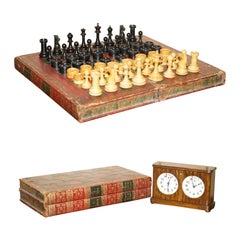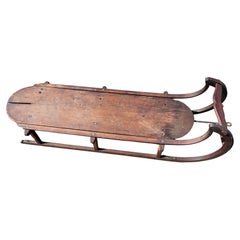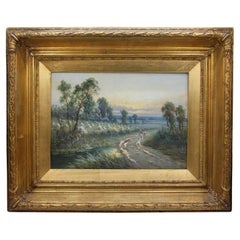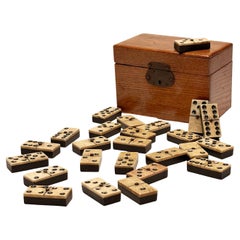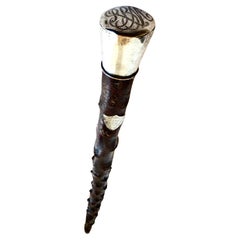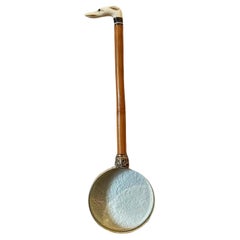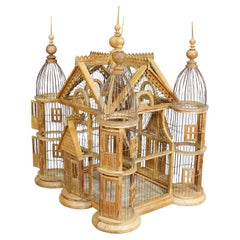Victorian Folk Art
to
34
216
74
297
2,005
1,055
680
297
197
195
162
85
85
76
55
41
38
31
23
20
7
2
195
100
81
5
6
12
3
7
1
4
140
130
43
39
31
209
86
71
56
34
297
297
297
1
1
1
1
1
Style: Victorian
Early 19th Century Ebony and Ivory Dominoes Set in Box
Located in Louisville, KY
Just imagine if these dominoes could share the many stories they've heard around the table from various players over the centuries.
This unique oak box with a small lock plate and ...
Category
Early 19th Century Unknown Antique Victorian Folk Art
Materials
Brass
19th C Blackthorn "Irish Walking Stick" With Presentation Inscription Dated 1887
Located in Incline Village, NV
Victorian Irish, late 19th century "presentation gift" walking stick with inscription etched onto a silver shield near the top; inscribed "Paul From Jim" Nov. 9th, 1887" with fleur ...
Category
1880s Irish Antique Victorian Folk Art
Materials
Silver, Pewter
Bespoke Antique Victorian Carved Ivory Dog Head Magnifying Glass Object of Vertu
Located in Forney, TX
A most charming fine quality antique Victorian era object of vertu magnifying glass, custom made from various earlier elements.
English refinement, sophistication, and Victorian ele...
Category
19th Century English Antique Victorian Folk Art
Materials
Metal
Antique Wooden Bird Cage Handmade in Germany ca. 1920s
Located in Berghuelen, DE
Antique Wooden Bird Cage Handmade in Germany ca. 1920s
A beautiful, handcrafted bird cage in the shape of a Victorian nobleman's house. It has 4 ...
Category
Early 20th Century German Victorian Folk Art
Materials
Metal
19th Century Complete Games Compendium in Hardwood Jointed Box Many Games
Located in Lincoln, Lincolnshire
This is a high quality Games Compendium, complete with over 8 individual games, all in its original hardwood storage box with a hinged lid.
All the pieces are well made and complete.
The box is made of a jointed hardwood, possibly red walnut and is a high quality piece in its own right.
The box has developed a lovely color and patination from use and wear.
The box lid has two brass hinges and two brass loop catches to secure it closed. The interior is sectioned into different sub compartments by hardwood dividers.
Many different games are included within the compendium, including;
Horse racing game...
Category
19th Century English Antique Victorian Folk Art
Materials
Brass
Child Dressing Mannequin, France
Located in Antwerp, BE
Original child figure mannequin on a wooden fully adjustable stand in a very good original condition, France, 19th century. Beautiful children's mode...
Category
1890s French Antique Victorian Folk Art
Materials
Wood
$519 Sale Price
58% Off
Antique Decorative Lead Plaque, Scandinavian, Viking, Arts and Crafts, Victorian
Located in Hele, Devon, GB
This is a heavy antique decorative lead plaque. A Scandinavian, relief panel with Viking long ship scene, dating to the Arts & Crafts movement of the late ...
Category
Late 19th Century Scandinavian Antique Victorian Folk Art
Materials
Lead
19th c French Children's Mannequin with Wooden Feet and Attachments
By Seigel
Located in Savannah, GA
This rare 19th century free-standing child's mannequin is probably from Siegel & Stockman, a Paris, France company that made tailor's dummies, window bustforms, mannequins and access...
Category
Late 19th Century French Antique Victorian Folk Art
Materials
Fabric, Wood
$875 Sale Price
30% Off
Summerly Mountain Landscape with Water Fall and Mountain Hut, 19th Century
Located in Berghuelen, DE
Summerly Mountain Landscape with Water Fall and Mountain Hut, 19th century
An antique oil painting depicting a mountain landscape with waterfall in front of a mountain shelter. Painted on canvas with pastell colors. Framed with antique decorative gilded frame. On the left base signed by the artist "Kuchl". Painted in the area of Tyrol or South Germany, late 19th century. A high quality antique oil painting which will highlight your alpine cabin wall decoration.
The Biedermeier period runs parallel to the Romantic period and both are characterized by similar features. Domesticity, closeness to nature, folksiness and need for harmony are buzzwords of this time. The focus is on the simple, the conservative and the tried and tested. There is little experimentation and more observation and enjoyment. The art style is kept very realistic and shows great similarity to photography. Domestic idyllic representations, beautiful landscape and impressive portraits are the most popular topics for oil paintings...
Category
Late 19th Century German Antique Victorian Folk Art
Materials
Wood, Canvas
A Large English Victorian Cast Iron Painted Doorstops, 19th Century
Located in ARMADALE, VIC
A Large English Victorian Cast Iron Painted Doorstops, 19th Century
Provenance: Private Australian Collection.
Dimensions:
Height: 41.5cm.
Width: 20cm.
Depth: 9cm.
Category
19th Century English Antique Victorian Folk Art
Materials
Iron
Boucherie Chevaline Trade Sign
Located in London, GB
Boucherie Chevaline Trade Sign
A hand crafted Boucherie Chevaline, zinc gold leaf hand beaten butchers trade sign. A highly decorative wall hanging in untouched condition with or...
Category
Early 20th Century French Victorian Folk Art
Materials
Zinc
Zinc French Butchers “Boucherie” Trade Sign, 19th Century
Located in London, GB
19th century Zinc French butchers “Boucherie” trade sign.
Referred to as a Boucherie, this handcrafted zinc horses head sign would have hung above a...
Category
Early 1900s French Antique Victorian Folk Art
Materials
Zinc
Early Stenciled Victorian Hand Crafted Winter Childs Sled
Located in Port Jervis, NY
Fabulous Victorian handmade winter Sled. Stenciled and in old red paint with hand wrought iron supports. 40.5 in length by 12 wide, so it can fit in many ...
Category
1870s American Antique Victorian Folk Art
Materials
Iron
Sailing Ship Diorama 19th Century Signed
Located in Norwood, NJ
George Vempley Burwood, British (1844-1917) signed and dated. Sailing ship, schooner diorama, shadow box with figures and painted background.
Category
1890s British Antique Victorian Folk Art
Materials
Glass, Wood, Paint
$2,231 Sale Price
25% Off
Antique Boule Set, Boule Balls, Pétanque, 1880s, France, Craftsmanship
Located in Greven, DE
Beautiful, unique Boule set of three Boule balls, France, late 19th century.
In the 19th century, antique metal boules balls experienced a renaissance that took the game of boules to a new level.
These ornately crafted balls were not only instruments of the game, but also symbols of elegance and sophistication in leisure activities.
Made from high-quality metals such as steel or brass, Boule balls were forged and polished by skilled craftsmen to ensure a smooth and even surface.
The antique boules...
Category
Late 19th Century French Antique Victorian Folk Art
Materials
Metal
1930s Swabian Hallic Country Pig Made of Terracotta
Located in Berghuelen, DE
1930s Swabian Hallic Country Pig Made of Terracotta
A vintage statue of a Swabian hallic country pig. It was used as shop window decoration in a German butchery. The statue is made ...
Category
Early 20th Century German Victorian Folk Art
Materials
Terracotta
Antique Victorian Quality Oil Painting by C R Breytle
Located in Suffolk, GB
Quality original antique oil painting of a horse, two dogs and a gentleman in wonderful colours and original gilt frame
A charming original artwork
H 40 x W 49 x D 5cm
Date 1880
Category
19th Century English Antique Victorian Folk Art
Materials
Paint
19th Century Paris Magicians Poster on Canvas
Located in London, GB
19th Century Paris Magicians Poster on Canvas
A rare example of a late 19th century lithograph on canvas Paris magician’s promotional poster. By Effi...
Category
Early 1900s French Antique Victorian Folk Art
Materials
Canvas
Early 20th century English Hand Painted “HELL” Sign
Located in London, GB
Early 20th century English Hand Painted “HELL” Sign
Originally this sign was reclaimed from a shoe shop named “Shellington Shoes” in Essex. Most of the sign was damaged but we luck...
Category
1920s British Vintage Victorian Folk Art
Materials
Pine
19th Century Bone Shoe Horn with Button Hook
Located in High Point, NC
19th century English bone shoe horn and button hook most likely for high button shoes in the Victorian period. There is a monogram which appears to be the letters S H. Wonderful de...
Category
19th Century English Antique Victorian Folk Art
Materials
Metal
Painting “Venice by Moonlight” by K. Nufer, Munich Late 19th Century
Located in Berghuelen, DE
Painting “Venice by Moonlight” by K. Nufer, Munich Late 19th Century
Magnificent antique painting in oil on canvas. Painted by K. Nufer Munich in the late 19th century. The painting...
Category
Late 19th Century German Antique Victorian Folk Art
Materials
Canvas, Wood
Antique Miniature Staffordshire Pottery Spaniel Dog Figurine with Confetti Fur
Located in Philadelphia, PA
A fine antique English Staffordshire pottery figurine.
Depicting a seated Spaniel.
With confetti fur and painted black highlights.
Simply a wonderful Staffordshire dog figurine...
Category
Late 19th Century British Antique Victorian Folk Art
Materials
Pottery
Large 19th Century 51-Inch Wooden Locksmith Key Trade Sign
Located in New York, NY
This 51-inch long locksmith key trade sign from the 19th century is a remarkable piece of craftsmanship, embodying the era's artisanal pride. Made from Painted wood, it showcases a w...
Category
19th Century Antique Victorian Folk Art
Materials
Wood, Paint
Early 20th Century Large Noah’s Ark
Located in London, GB
Early 20th Century Large Noah’s Ark
A larger than usual example of an early 20th Century hand carved / painted pine Noah’s ark. With lifting roof and sectioned lifting central hul...
Category
1920s British Vintage Victorian Folk Art
Materials
Wood
Original Nautical Mast figurehead
Located in Sag Harbor, NY
This antique mast figure is French and as the story goes salvaged off a French Ship damaged in the Anglo-French War (1803–1815). The one side shows fire damage and is burned in charc...
Category
Mid-19th Century French Antique Victorian Folk Art
Materials
Iron
Late 19th C Memento Mori Calligraphy In memory of Maria Arthur Manchip Died 1899
Located in Lowestoft, GB
A fantastically decorative pen and ink calligraphy composition celebrating the life of a Maria Arthur Manchip who dies 1899.
On paper, in a gl...
Category
Late 19th Century English Antique Victorian Folk Art
Materials
Glass, Wood, Paper
Antique Boule Set, Boule Balls, Pétanque, 1880s, France, Craftsmanship
Located in Greven, DE
Beautiful, unique Boule set of three Boule balls and one target ball, France, late 19th Century.
Diameter 8,5 cm.
Fantastic colour and patina!
In the 19th century, antique metal boules balls experienced a renaissance that took the game of boules to a new level.
These ornately crafted balls were not only instruments of the game, but also symbols of elegance and sophistication in leisure activities.
Made from high-quality metals such as steel or brass, Boule balls were forged and polished by skilled craftsmen to ensure a smooth and even surface.
The antique boules...
Category
Late 19th Century French Antique Victorian Folk Art
Materials
Metal
Circa 1880 Victorian English Countryside Painting
By J.S. Henry
Located in Chapel Hill, NC
Circa 1880 Victorian English country side painting, English. A winding road through haystack fields with a couple coming in from work. Thatched roof farmhouse complex & distant villa...
Category
1880s English Antique Victorian Folk Art
Materials
Canvas, Wood
Antique Victorian Press - Mahogany
Located in Casteren, Noord-Brabant
A beautiful small antique press, made of mahogany wood.
The press was used as a hobby, for example for pressing flowers, for example for making herbariums, a popular hobby at the end...
Category
1870s British Antique Victorian Folk Art
Materials
Metal
19th C Folk Art J.Wheatley Jones Oil on Board Dog & Interior "Inferno" 1887
Located in Lowestoft, GB
A charming oil on board painting of a pondering dog in a country house kitchen. Age related craquelure to the painted surface, the odd knock and abrasion to the gilt gesso frame. But...
Category
Late 19th Century English Antique Victorian Folk Art
Materials
Canvas, Pine
Victorian Unusual Hand Sculpted Leather Lioness Figure
Located in Bishop's Stortford, Hertfordshire
A stylish and unusual Victorian hand sculpted pressed leather figure of a lioness dating from the latter 19th century. The figure is beautifully made and portrays a prowling lioness ...
Category
Late 19th Century British Antique Victorian Folk Art
Materials
Leather
The Holy Bible With An Abridgement Of The Commentaries Of Scott And Henry
Located in Islamabad, PK
The Holy Bible With An Abridgement Of The Commentaries Of Scott And Henry
Bound in full navy Morocco with the covers displaying open-tooled bordering details, an indented central ti...
Category
19th Century British Antique Victorian Folk Art
Materials
Gold Plate
Collection of 3 Italian 19th Century Marionettes
Located in London, GB
Collection of 3 Italian 19th century Marionettes
A fantastic set of 3 19th century hand crafted marionette puppets. All with original cotton, silk and valour clothing intact, han...
Category
19th Century Italian Antique Victorian Folk Art
Materials
Pine
Antique French Velocipede Horse Tricycle by Jean Louis Gourdoux for Jugnet
By Jean Louis Gourdoux
Located in Brooklyn, NY
Wonderfully detailed, antique, French, velocipede or toy tricycle featuring the body of a carved walnut horse with steel face plate on spoke wheels and ho...
Category
Late 19th Century French Antique Victorian Folk Art
Materials
Brass, Steel
Vernier Octant by John Todd, London
Located in Norwich, GB
Vernier Octant by John Todd, London, circa 1850.
An eleven inch radius vernier octant by John Todd with ebonised wooden frame with inset bone scale marked ...
Category
1850s English Antique Victorian Folk Art
Materials
Brass
Jaques London Victorian Faux Book Chessboard Staunton Pieces & Hardwood Clock
Located in West Sussex, Pulborough
We are delighted to offer for sale this stunning original Victorian Antique Jaques of London faux leather folding book chessboard with the original Staunton Chess set dating to circa 1880, a travel chess set in the form of checkers pieces and lastly a Jacques of London Rosewood Chess clock...
Category
1880s English Antique Victorian Folk Art
Materials
Leather, Hardwood, Boxwood
$6,670 Sale Price
20% Off
Early 20th Century Double Sided French Pharmacy Metal Sign
Located in London, GB
Early 20th Century Double Sided French Pharmacy Metal Sign
A rare double sided pharmacy trade sign, origins of France, dated to the early part of the 20th century, made from metal ...
Category
1920s Vintage Victorian Folk Art
Materials
Metal
Fully Restored Victorian Rocking Horse
Located in London, GB
A beautiful, fully restored Victorian rocking horse complete with a studded leather saddle, blue saddle blanket and leather reins and stirrups....
Category
Late 19th Century English Antique Victorian Folk Art
Materials
Wood
Late 19th Century English Folk Art Articulated Jig Doll
Located in London, GB
Late 19th century English Jig Doll
A wonderful example of a late 19th century English jig doll called porkpie. A fully articulated hand carved feature. With amazing leather handcrafted boots and wearing a porkpie hat. A lovely example with wear and patination in all the right areas. Jig dolls are traditional wooden or tin-plate toys for adults or children. They are dolls with loose limbs that step dance...
Category
1890s British Antique Victorian Folk Art
Materials
Leather, Pine, Paint
Large Antique Oval Hand Painted Portrait of a Woman on a Porcelain Wall Plaque
Located in Hamilton, Ontario
This antique hand painted portrait is unsigned, but done in Europe, most likely Austria or Italy in circa 1890 in the period Victorian styl...
Category
Late 19th Century Austrian Antique Victorian Folk Art
Materials
Porcelain
Antique Vienna Bronce Bear on a Crystal Rock
Located in Berghuelen, DE
Antique Vienna Bronce Bear on a Crystal Rock
Item e7254
A beautiful small bronze statue of a wandering bear mounted on a crystal rock. A magnificent, realistic example of the famous ...
Category
Early 20th Century German Victorian Folk Art
Materials
Rock Crystal, Bronze
Wooden Carved Lusterweibchen of a Medieval Noble Lady ca. 1900
Located in Berghuelen, DE
Wooden Carved Lusterweibchen of a Medieval Noble Lady ca. 1900
Item e7362
An antique lusterweibchen with a hand carved and stained statue of a medieval lady with wine glass. Mounted ...
Category
Early 20th Century German Victorian Folk Art
Materials
Metal
19th Century English Hand-Carved Bread Board
Located in High Point, NC
19th century English bread board made from sycamore. the border is hand carved with the word bread and a hand-carved design of oak leaves and acor...
Category
19th Century English Antique Victorian Folk Art
Materials
Sycamore
19th Century Original Oil Painting of Nobleman
Located in Scottsdale, AZ
19th Century Original Oil Painting of Nobleman. Striking piece with age appropriate wear, see condition details below. Most likely English but could be French with English frame. ...
Category
19th Century English Antique Victorian Folk Art
Materials
Canvas, Paint
Antique Lusterweibchen of a Medieval Noble Lady ca. 1880s
Located in Berghuelen, DE
Antique Lusterweibchen of a Medieval Noble Lady ca. 1880s
A great antique chandelier featuring a medieval noble lady holding a heraldic blazon. The sculpture is made of handcarved a...
Category
Late 19th Century German Antique Victorian Folk Art
Materials
Iron
Patinated Bronze School Bell or Town Crier Bell
Located in Los Angeles, CA
A wonderfully patinated school or town crier bell. While it works great, it would be a terrific decorative piece, especially on a console table with a story of primitive items and b...
Category
19th Century Antique Victorian Folk Art
Materials
Bronze, Iron
19th Century French folk-art militaria painting
Located in London, GB
19th Century French folk-art militaria painting
19th Century piece of French folk-art militaria art, gouache on paper in its original frame still with vibrant colours and detail as ...
Category
1850s French Antique Victorian Folk Art
Materials
Paper
Antique Fairground Paper Mache Sculpture of a Witch or Farmer's Wive
Located in Berghuelen, DE
Antique Fairground Paper Mache Sculpture of a Witch or Farmer's Wive
A large half-relief sculpture of the witch from the fairy tale Hansel and Gretel. Probably used as decoration in...
Category
Early 20th Century German Victorian Folk Art
Materials
Wood, Paper
British Sailor's Woolwork of a Royal Navy Ship with Red Ensign
Located in Downingtown, PA
British Sailor's Woolwork of a Royal Navy Ship
circa 1765
The sailor's woolwork, also known as a woolie, depicts a port side view of a ...
Category
Mid-19th Century English Antique Victorian Folk Art
Materials
Wool
Vintage Porcelain Bear Statue, Germany, ca 1950s
Located in Berghuelen, DE
Vintage Porcelain Bear Statue, Germany, ca 1950s
Item e7269
An old porcelain bear statue, decorated with polychrome colors. Made in Germany ca. 1950s. Illegible maker's signature on ...
Category
Mid-20th Century German Victorian Folk Art
Materials
Porcelain
J. Alden Weir Hand Made Studio Sign Branchville Connecticut
Located in Garnerville, NY
Recently purchased from a multi-generational Ridgefield, CT estate of the former President of Ridgefield Savings Bank. Our esteemed and avid collector found time in his off hours in Post World War II Connecticut to scour the countryside for just about anything that struck his fancy. He had an enormous passion for model trains, porcelain figurines and pattern Depression Era glass...
Category
Late 19th Century American Antique Victorian Folk Art
Materials
Iron
Fine Quality Antique French Toy "Dancing Couple", circa 1880, Rare
Located in Incline Village, NV
One of a kind, fine quality antique toy, "Dancing Couples" is of French manufacture, it is marked in raised lettering "A.L. Paris" at the top of the base. It is also very similar to several French toys noted in "Antique Toys" by Jeffrey Levitt, and the young lady's face is almost identical to the bisque face on a French toy referenced on page 209 plate #372.
This outstanding toy consists of two figures, a young man resembling Napoleon Bonaparte, and a young lady, dressed in period clothes with bisque (porcelain) faces and heads and wooden legs. The base is some type of metal composite consisting of a cast lead alloy. The polychromed hand painted blue and red metal dance floor is also a lead alloy. The wire stands supporting the figures is of ferrous metal.
The bisque faces are very lifelike with flesh tones and blue eyes, rosy cheeks to the lady with bisque auburn hair. He is dressed in original period Napoleon type military clothes...
Category
1880s American Antique Victorian Folk Art
Materials
Metal
Sailor's Woolwork (Woolie) with Heart Valentine and Flag Surround
Located in Downingtown, PA
Sailor's Flag of Nations Woolwork with Heart Valentine and Flag Surround,
Circa 1880
The distinctive British sailor's woolwork or woolie showcases a flag designed in a patriotic sty...
Category
1880s English Antique Victorian Folk Art
Materials
Wool
Carl Euler - Bear Hunt in the Zillerthaler Alps, Oil Painting on Board 1889
Located in Berghuelen, DE
Carl Euler - Bear Hunt in the Zillerthaler Alps, Oil Painting on Wooden Board 1889
An impressive oil painting depicting a high mountain landscape with mount...
Category
Late 19th Century German Antique Victorian Folk Art
Materials
Wood
Miniature Salesman's Sample Victorian Bureau Chest, American, circa 1890
Located in Incline Village, NV
This late 19th century miniature 3-drawer dresser with original mirror mounted above, was likely used as a salesman's sample by an itinerant sales person who traveled the countryside promoting his articles, usually by seeking out merchants to take orders based on this scaled down miniature bureau, or by leaving it on display in a merchant's establishment to take orders from that merchant's customers.
This American bureau...
Category
1890s American Antique Victorian Folk Art
Materials
Oak
Handcrafted Natural Coastal Sea Shell Encrusted Anchor Wall Hanging
Located in Oklahoma City, OK
A natural hand-crafted sea shell encrusted anchor wall hanging. Created from wood, this piece is in the shape of a boat anchor, and features applied natural sea shells of all colors....
Category
20th Century American Victorian Folk Art
Materials
Shell, Wood
$240 Sale Price
20% Off
Wooden Carved Lusterweibchen of a Medieval Noble Lady ca. 1910
Located in Berghuelen, DE
Wooden Carved Lusterweibchen of a Medieval Noble Lady ca. 1910
Item e7360
An antique chandelier - a so-called lusterweibchen - with a hand-carved and painted statue of a medieval lady holding a carpenter's guild sign...
Category
Early 20th Century German Victorian Folk Art
Materials
Iron
19th Century Mannekin Head
Located in Vosselaar, BE
A 19th century French mannekin head in beech with original polychrome remains.
Category
Late 19th Century French Antique Victorian Folk Art
Materials
Beech
1930s Swabian Hallic Country Pig Made of Terracotta
Located in Berghuelen, DE
1930s Swabian Hallic Country Pig Made of Terracotta
A vintage statue of a Swabian hallic country pig. It was used as shop window decoration in a German butchery. The statue is made ...
Category
Early 20th Century German Victorian Folk Art
Materials
Terracotta
Antique Hardwood Vesta Case with fine Shell Patera Inlay, late 19th Century
Located in Lincoln, Lincolnshire
This is a very good quality antique Vesta case, all handmade from various hardwoods and having well detailed shell inlay, dating to the 19th Century, Circa 1880.
The case is all han...
Category
Late 19th Century English Antique Victorian Folk Art
Materials
Hardwood
Victorian folk art for sale on 1stDibs.
Find a broad range of unique Victorian folk art for sale on 1stDibs. Many of these items were first offered in the Late 20th Century, but contemporary artisans have continued to produce works inspired by this style. If you’re looking to add vintage folk art created in this style to your space, the works available on 1stDibs include folk art, more furniture and collectibles, decorative objects and other home furnishings, frequently crafted with wood, metal and other materials. If you’re shopping for used Victorian folk art made in a specific country, there are Europe, United Kingdom, and England pieces for sale on 1stDibs. While there are many designers and brands associated with original folk art, popular names associated with this style include Staffordshire, A. Lietz Co., Alfred Renoleau, and Beers Atlas Co.. It’s true that these talented designers have at times inspired knockoffs, but our experienced specialists have partnered with only top vetted sellers to offer authentic pieces that come with a buyer protection guarantee. Prices for folk art differ depending upon multiple factors, including designer, materials, construction methods, condition and provenance. On 1stDibs, the price for these items starts at $115 and tops out at $30,000 while the average work can sell for $1,003.
